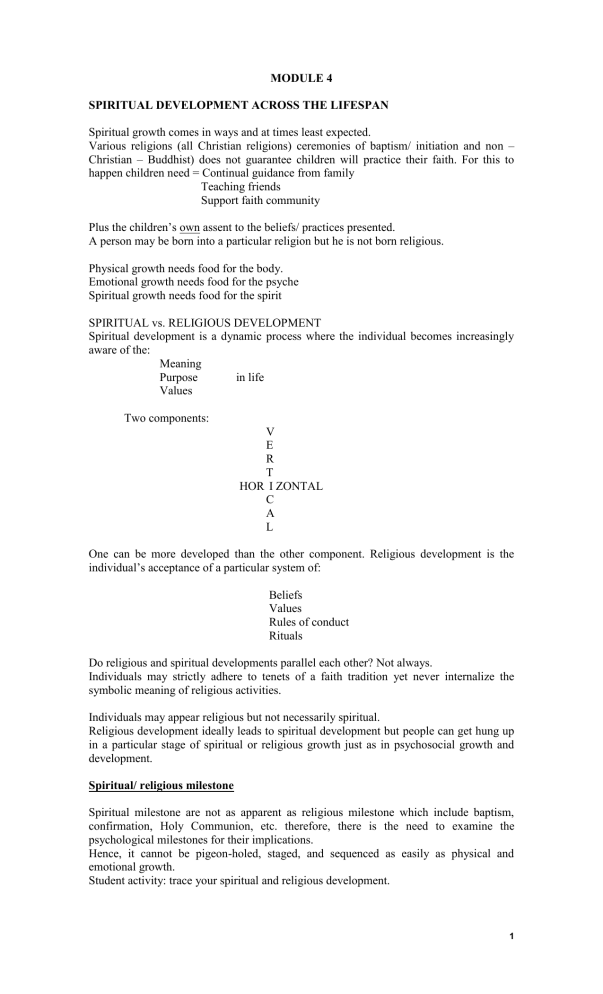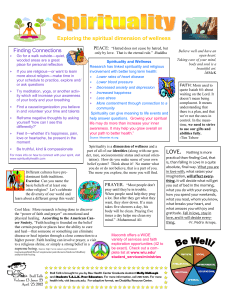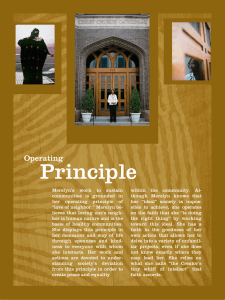
MODULE 4 SPIRITUAL DEVELOPMENT ACROSS THE LIFESPAN Spiritual growth comes in ways and at times least expected. Various religions (all Christian religions) ceremonies of baptism/ initiation and non – Christian – Buddhist) does not guarantee children will practice their faith. For this to happen children need = Continual guidance from family Teaching friends Support faith community Plus the children’s own assent to the beliefs/ practices presented. A person may be born into a particular religion but he is not born religious. Physical growth needs food for the body. Emotional growth needs food for the psyche Spiritual growth needs food for the spirit SPIRITUAL vs. RELIGIOUS DEVELOPMENT Spiritual development is a dynamic process where the individual becomes increasingly aware of the: Meaning Purpose in life Values Two components: V E R T HOR I ZONTAL C A L One can be more developed than the other component. Religious development is the individual’s acceptance of a particular system of: Beliefs Values Rules of conduct Rituals Do religious and spiritual developments parallel each other? Not always. Individuals may strictly adhere to tenets of a faith tradition yet never internalize the symbolic meaning of religious activities. Individuals may appear religious but not necessarily spiritual. Religious development ideally leads to spiritual development but people can get hung up in a particular stage of spiritual or religious growth just as in psychosocial growth and development. Spiritual/ religious milestone Spiritual milestone are not as apparent as religious milestone which include baptism, confirmation, Holy Communion, etc. therefore, there is the need to examine the psychological milestones for their implications. Hence, it cannot be pigeon-holed, staged, and sequenced as easily as physical and emotional growth. Student activity: trace your spiritual and religious development. 1 ROLE OF FAITH AND HOPE IN SPIRITUAL DEVELOPMENT I. Faith Multidimensional word: As a noun: refers to a belief in or assent to something unseen. Verb: a way of being, living, imaging. It is a pre – requisite for spiritual growth to occur. Two qualities: 1. Faith given (vertical) It is a gift from a Supreme being. “Lord, I believe, help my unbelief” It is a leap from what is to what is not known. 2. Faith developed: developmental. (Horizontal) It matures and changes in response to life events. Belief in God as a punitive God: (“Papa Dios will punish you if are bad.”) To a loving God who loves unconditionally. FOWLER’S SEVEN STAGES OF FAITH PRIMAL FAITH (INFANCY): A pre-language disposition of trust forms the mutuality of one’s relationships with parents and others to offset the anxiety that results from separation that occur during infancy. INUITIVE: Projective faith (early childhood): Imagination, stimulated by stories, gestures, and feelings to create long – lasting images that represent both the protective and threatening power surrounding one’s life. MYTHIC – LITERAL FAITH (childhood and beyond): the developing ability to think logically helps one order the world with categories of casualty, space, and time; to enter into the perspectives of others; and to capture life. SYNTHETIC – CONVENTIONAL FAITH (adolescence and beyond) new cognitive abilities make mutual perspective – taking possible and require one to integrate diverse self – images into a coherent identity. A personal and largely unreflective synthesis of and values evolves to support identity and to capture unite one in emotional solidarity with others. INDIVIDUATIVE – REFLECTIVE FAITH (young adulthood and beyond): Critical reflection one’s beliefs and values, understanding of the self and others as part of a social system, and the assumption of responsibility for making choices of ideology and life style open the way for commitments in relationships and vocation. CONJUNCTIVE FAITH (midlife and beyond): the embrace of polarities in one’s life, alertness to paradox, and the need for multiple interpretations of reality mark this stage. Symbol and story, metaphor and myth (from one’s own tradition and others), are newly appreciated as vehicles for grasping truth. UNIVERSALIZING FAITH (midlife or beyond): Beyond paradox and polarities, persons in this stage grounded in a oneness with the power of being. Their visions and commitments free them for a passionate yet detached spending of the self in love, devoted to overcoming division, oppression, and brutality. ADEN’S EIGHT STAGES OF FAITH FAITH AS TRUST (infancy): Infants develops a basic sense of trust toward self and others. This may form the basis for trust in a higher being. FAITH AS COURAGE (early childhood): Child learns when to “let go and take hold to affirm self in an undifferentiated way. this primitive faith allows an adult to feel affirmation of self in relation to a higher being.” FAITH AS OBEDIENCE (preschool): child learns to balance self – assertion to the will of others. The child learns to balance inner desires with requirements made by others. This faith is ultimately translated into obedience to what are perceived to be the demands of Supreme Being. FAITH AS ASSENT (school age): Child seeks to master his or her universe and to be competent. This seeking of competence extends to knowledge and understanding of a supreme being. 2 FAITH AS IDENTITY (adolescence): Adolescence seeks ego identity, which consists of a realistic knowledge and experiences between how he or she is viewed by society. This gives a sense of unity to self. The successful accomplishment of this task allows the adolescent to view the self as worthy in relationship to a supreme being. FAITH AS SELF – SURRENDER (young adulthood): the individual learns to give of self wholeheartedly in a reciprocal relationship. This actualizes the individual’s need to give self to a reality that is larger and yet more basic than the thoughts and desires of self. FAITH AS UNCONDITIONAL CARING (midlife): the individual is faced with the challenge of making a significant contribution to humankind and becoming a proactive source of generation and nurturance. In relation to a higher being, the individual loves the being with all his or her heart, soul, and mind. FAITH AS UNCONDITIONAL ACCEPTANCE: Individual is faced with the challenge of finding meaning in the face of physical decline. In the struggle of faith emerges as the affirmation of both the finite and the eternal value of life. WESTERHOFF’S FOUR STAGES OF FAITH EXPERIENCED FAITH (infancy – early adolescence): Children experience faith by interacting with others who are living a particular faith tradition. AFFILLATIVE FAITH (late adolescence): adolescents actively participate in activities that characterize a particular faith tradition. The adolescent feels a sense of belonging, experiences an awe and wonderment, and acknowledges the authority of the faith community to which the adolescent belongs. SEARCHING FAITH (young adulthood): The young adult engages in a process of questioning and doubting his or her faith. Out of this struggle, the individual acquires a cognitive as well as an affective faith. OWNED FAITH (middle adulthood – old age): People desire to put faith into personal and social action, and they are willing to stand up for what they believe, even against their community of nurture. Age Period Infancy ERIKSON Trust vs. mistrust ADEN Faith as trust FOWLER Stage of undifferentiated WESTERHOFF Early childhood Autonomy vs. shame and doubt Faith as courage Stage I Intuitive projective Experienced faith Preschool Initiative vs. guilt Faith as obedience School age Industry vs. inferiority Stage II mythical – Faith as assent literal Adolescence Identity vs. role confusion Young adulthood Adulthood Maturity Intimacy vs. isolation Generativity vs. stagnation Ego - integrity vs. despair Faith as identity Faith as surrender Faith as unconditional surrender Faith as unconditional acceptance Stage III Synthetic conventional Affiliative faith Stage IV Individuality reflexive Searching faith Stage V Polar – dialectical Stage VI Universalizing Owned faith 3 HOPE HOPE is critical to spiritual development and possesses both vertical and horizontal dimension WEISSMAN identifies hope as pre – requisites for effecting coping with the demands and challenges of life events such as illness, misfortunes, and crises. FOUR MAJOR THEMES ASSOCIATED WITH HOPE 1. Orientation towards the future Future can be anything relevant to the person 2. Goal setting Goal can be = earthly (material) or divine 3. Action plan to meet goal achieves. “With hope, man acts, moves achieve. Without hope, he is often dull, listless, moribund.” Establishing interpersonal relationship – body experiences hunger and the satisfactions of that hunger because of such experiences if ever since he is hungry (hope) that his hunger will be alleviated. According to Erickson, hope is the outcome of achieving an appropriate balance between trust and mistrust and therefore, is the first developmental task of life. Trust in others, self, and the environment is the genesis of hope. Hope that is grounded only in the world will result to disappointed/ despair, Hope grounded on the Supreme being is sustained with peace and joy in spite of disappointments. Student Activity: Ask class to identify implementations to caregivers. SPIRITUAL DEVELOPMENT ACROSS THE LIFE SPAN 1. INFANCY Babies are born without religious beliefs. Have undefined spiritual life. Therefore, infancy plays a significant role in the development of both religious belief and spirituality. Without words and the ability to conceptualize infants learn about the world through experiences with the caregivers. Such experiences create images linked with feelings in the baby’s mind. If mother cares for the baby with gentleness, consistency and love the baby experiences, feelings of trust and the baby begins to HOPE to anticipate the future, to hope that needs will be met and comfort will be given. Q- What is the role of infancy in the development of both religious beliefs and spirituality? HOPE This most critical psycho – social stage is characterized by the need to balance trust with mistrust. Erickson claims that the development of a healthy balance between trust and mistrust affects all of life’s experiences including the ability to participate in an organized religion. The model of the mother – baby relationship in which the baby is totally dependent on the mother to have needs met, can translate to a creator = creature model. Such a model will form the basis for religious as well as vertical/ horizontal spiritual development. 2. EARLY CHILDHOOD (2 –3 yrs.) Developmental task – mastering motor skills, child’s ability to move around, explore, touch, taste make the child assert self and acquiesced to another. In toilet training, the child learns to yield or assert self in the child gains a 4 sense of self – worth and power. In both religious and spiritual sense, this sense of self – worth is important. The groundwork for spiritual development requires self – worth. Horizontally. Individual who feel unworthy will have difficulty accepting the worth of other people, values and endeavors outside of them. Vertically. Spiritual development requires that individual believe that a Supreme Being loves them for who they are at any given moment and that they are lovable to God. Lack of self – worth or feeling of shame can block an individual’s acceptance of anyone’s love, including the love of God. According to Fowler, the child’s faith takes the form of images influenced by what the parents say, experiences at church, religious education, stories, religious rituals such as vocal prayers, bedtime prayers, religious holidays create long lasting impressions/ images that influence the spiritual and religious development – the beginning of experienced faith passively acquired from the interaction and experiences shared with significant others. 3. PRE – SCHOOL (4 – 5 yrs.) Task – balancing self – assertion and self-discipline. Inability to achieve this balance causes child to feel guilty. This stage is facilitated by child’s increasing skill in both language and task with implications for both having horizontal/ vertical spiritual development. Strict parents who teach child who disobeys as bad and acceptable will have undesirable effects on religious development. Child will view religion as a restraining force and God as a punitive God, not a loving God. Others will grow up so controlled by rules they become religious fanatics unable to differentiate the letter of the law from the spirit. 4. SCHOOL AGE (6 - 10) Task – industry and competence. The child masters proficiency and knowledge in the art of doing things. Failure to accomplish this task will lead to feeling of inferiority. Effects: affects person’s participation in an organized religion. Decrease appreciation of personal talents and capabilities Diminished ability to relate with others including God. 5. ADOLESCENCE Time of conflicts and rebellion as individual struggles to achieve a clear sense of who they are and where they are going. Must have sense of self-identity, before they can be true to others, self and God. Inability to accomplish this task will result to confused person. It is a stage of questioning. 6. YOUNG ADULTHOOD Developmental task = generativity. Having attained self – identify, the person can commit herself now to intimate relationships. A healthy balance between intimacy and isolation results to Self Love of Others God Call of intimacy with God Religious vocation marriage single life 5 7. MIDDLE ADULTHOOD Developmental task = generativity. Balance between generativity and stagnation results to care and caring. Nurturing of children; sharing in the generativity of God. There is also an increased turning inwards. 8. LATER MATURITY Developmental task; achieve balance between ego integrity and despair results to wisdom. Vertical spiritual growth is manifested in: 1. Service – James 2:14 – 17 2. Prayer – Central to spiritual growth and God related ness 3. Stewardship – caretaker Nursing Implications: 1. Spirituality is not something to be judged but assessed and accepted. 2. Interventions at the physical/ psychological – social levels are also interventions for the spiritual needs of horizontal dimension. 3. Awareness that spirituality progresses over life span. SPIRITUALITY OF THE NURSE PRAYER I. Definition: Lifting up of one’s mind and heart to God. II. Descriptions: 1. Prayer is an activity of faith. 2. Prayer is a privilege. It is privilege to be able to communicate with God, who is totally available at any time and for as long one wants. 3. Prayer is a gift It is the creator who initiates, who invites, who reaches out first. 4. Prayer leads to union with God. The most important purpose of prayer is union with God. 5. Prayer is an experience of God loving you and in return an expression of your love for God. 6. Prayer centered more on God’s activity than on your own is an activity of greater faith. It takes great faith and humility to sacrifice some of the satisfaction that comes from a more active form of prayer in order to be more attentive to what God is doing. 7. It is spirit of God who guides and directs you in prayer. No one can say ‘Jesus’ unless he is under the influence of the holy spirit (1 Cor 12:3) 8. Prayer is sacrifice possessed by God and transformed by him. 9. Prayer is a sacrifice of time. By spending or sacrificing time in prayer we offer something very precious to the Lord. In prayer, we return to the Lord some of the time that he entrusts to us. 10. Prayer is a time to experience our helplessness and poverty. During the day, we are busy with many different activities. These activities especially if they are very satisfying and successful, might create the illusion that we can get along pretty well without God. What happens in prayer depends primarily on God. He is the giver. He is in control. We come to him empty because we are empty. As we sit in the Lord’s presence during prayer we can experience this emptiness and helplessness even physically. Sitting is a helpless position; it is a position of waiting. This “desert experience” is a normal part of our progress in prayer. 6

